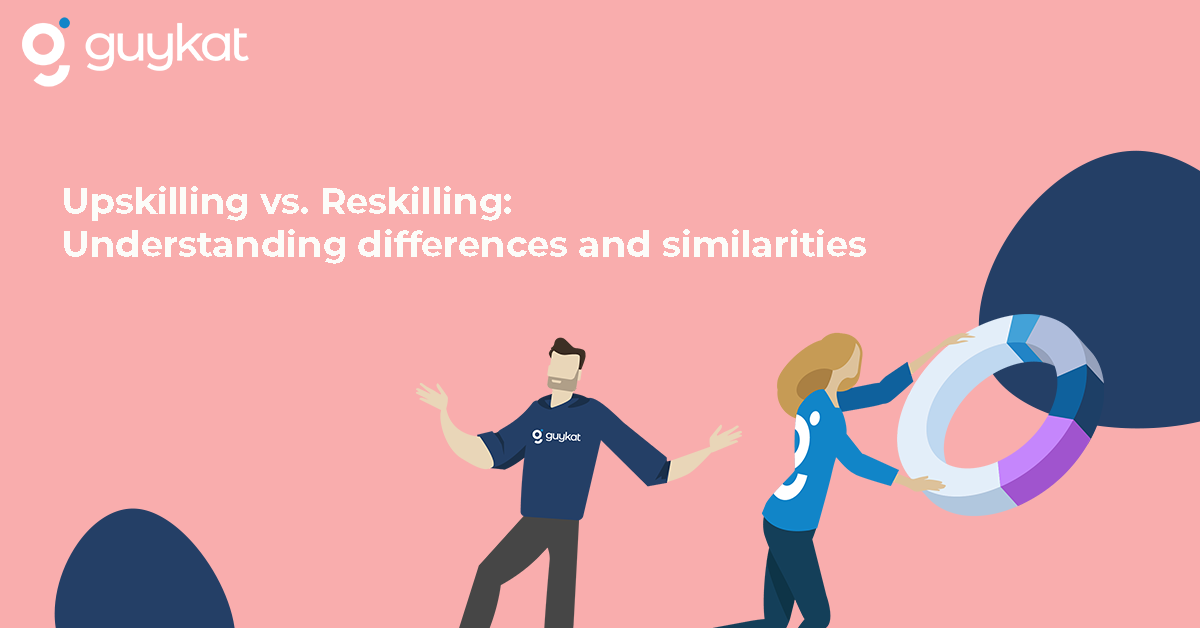Like most industries, L&D professionals have a habit of using industry jargon. Jargon can exclude bright people from being able to make valid contributions to a debate. At GuyKat, we want to be inclusive. We’re on a mission to bust the jargon. Last week we demystified the words ‘asynchronous’ and ‘synchronous’. This week we’re ready to do the same with ‘upskilling’ and ‘reskilling’…
What is upskilling?
In short, upskilling is learning fresh skills to meet the demand for new expertise. For companies, it’s a way to teach workers what they need to do their work to the best of their abilities. For employees, it’s a way to further their career path.
One example of successful upskilling is PwC, which created a ‘digital fitness’ program to teach its employees a broad range of technical skills, from programming to data analysis. To do this, the company combined several tools—apps, quizzes, podcasts, and gamification. The goal was to encourage a growth mindset and nurture competencies that will contribute back to the team.
What is reskilling?
While upskilling aims to train workers to do their current jobs better, reskilling teaches skills for employees to embark on new positions within the company. Often, the new skills are related to the ones the worker had before, but it’s not unusual for a person to dive into an entirely different niche.
One example is Scandinavian Airlines. Lockdown and travel restrictions hit the airline industry especially hard, endangering hundreds of thousands of jobs worldwide. In this context, Scandinavian Airlines positioned hundreds of workers with basic medical training in the Swedish healthcare sector by offering a three-and-a-half training course.
Both upskilling and reskilling have their advantages based on the goals of the company and the employee.
Benefits of upskilling
Attracting better talent
Top talent cares about gaining more knowledge and experience. So, companies that invest in training and upskilling will attract applicants with a growth mindset.
Improving motivation and loyalty
Employees take note when businesses invest in training, making them feel the company is committed to their growth. In turn, this boosts morale and improves performance.
Promoting stability
Ensuring that all team members have the skills to protect teams when one employee leaves, as it’ll make it easier for a new person to take over the role.
Benefits of reskilling
Reduces hiring and onboarding costs
It may take up to 50 days and over $4,000 to hire a new employee. Reskilling an employee to perform a different role within the company cuts down on these costs and it decreases the time the person will need to adapt to the new team.
Keeping talent
Providing workers with options to gain new skills and explore different paths within the company is a sure way to retain talent that would otherwise leave the company.
Retaining company knowledge
By retaining talent, companies not just ensure employees feel valued. It also guarantees the resources the company invested in nurturing a high-performing employee by teaching them that knowledge will continue to yield results.
Upskilling vs Reskilling: Which One To Choose?
Both are valuable training approaches, and choosing one over the other will depend on the goals and needs of the company and the employees.
There are several ways to teach new skills in a business setting, but three stand out:
Based on learning objectives
It refers to more structured, formal training programs like online or on-site courses or degrees. It allows employers to set up more easily quantifiable goals and clear timelines. In turn, this makes it easier for management to evaluate the results and investment of the program.
Based on learning experience
Experiential learning is another way to train employees in a more informal, practical, and hands-on approach. The goal is to create an immersive experience that will help employees to learn by doing, applying their skills in realistic scenarios.
Often, learners can use a broad range of tools—from Virtual Reality and simulations, games, projects, and peer collaboration.
Blended learning
Many skills require a combination of learning journeys, using structures programs, and practical experience to cement new skills. For example, online programs can be project-based or use games, apps, VR, or peer coaching to reinforce theory learned during class.
Why are reskilling and upskilling so important now?
In January 2020, the World Economic Forum estimated that 54% of all employees will need to be reskilled by 2022 to meet the demand for new jobs disrupted by technology.
For companies, this means massive gaps in knowledge and skills they’ll need to cover to continue operating with the same levels of productivity and efficiency.
Another significant change the pandemic has caused is the increased number of resignations across middle-career workers and management in sectors like healthcare and tech. Offering training and mobility can be a determining factor in retaining talent.


